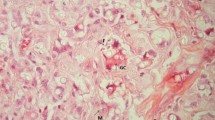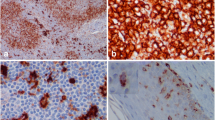Summary
Epidermal Langerhans cells (LC) are required for antigen-presentation and for stimulating antigen-specific T cell activation. Similar functions may be important in the immune response to malignant skin tumours. Monoclonal anti-T6 antibody was used to examine LC population in basal and squamous cell carcinomas. Positive control labeling was performed with monoclonal anti-HLA-DR antibody.
The number of T6-positive LC per mm2 of section was significantly decreased (p<0.01) in the tumour group in comparison with a sex and age-matched control group. The number of sun-exposed and covered regions was taken into consideration in each respective group. Within the tumours, LC were found more frequently in the tumour periphery and in most differentiated tumour areas (horn pearls) than in the rest of the tumour mass. T6-positive LC were rarely found in the dermis. Moreover, LC exhibited morphological changes in specimens from tumours. Staining with anti-HLA-DR antibody revealed less numerous positive cells within tumour nests than labeling with OKT6. A relationship between T6-positive LC quantities and extent of HLA-DR-positive infiltrates around tumours could not be established. These results suggest that immunological surveillance of neoantigen-bearing tumour cells may be impaired in skin cancer. A reason for the reduced LC number may be an altered microenvironment in tumour tissue.
Similar content being viewed by others
References
Berman B, Chen VL, France DS, Dotz WJ, Petroni G (1983) Anatomical mapping of epidermal Langerhans cell densities in adults. Br J Dermatol 109:553–558
Bjercke S, Elgo J, Braathen L, Thorsby E (1984) Enriched epidermal Langerhans cells are potent antigen-presenting cells for T cells. J Invest Dermatol 83:286–289
Braathen LR, Thorsby E (1980) Studies on human epidermal Langerhans cells. I. Allo-activating and antigen presenting capacity. Scand J Immunol 11:401–408
Claudy AL, Viac J, Alario A, Thivolet J (1976) Identification of mononuclear cells infiltrating basal cell carcinoma. Acta Derm Venereol (Stockholm) 56:361–365
Czernielewski J, Vaigot P, Asselineau D, Prunieras M (1984) In vitro effect of UV radiation on immune functions and membrane markers of human Langerhans cells. J Invest Dermatol 83:62–65
Dagnelie P (1975) Théorie et méthodes statistiques (Vol 2). Les Presses Agronomiques de Gernbloux. Gernbloux (Belgium)
DeLeo V, Dawes L, Jackson R (1982) Density of Langerhans cells in normal versus chronic actinically damaged skin (CADS) of humans. Clin Res 29:592A
Epstein JH (1983) Photocarcinogenesis, skin cancer, and aging. J Am Acad Dermatol 9:487–502
Faure M, Frappaz A, Schmitt D, Dezutter-Dambuyant C, Thivolet J (1984) Role of HLA-DR-bearing Langerhans and epidermal indeterminate cells in the in vitro generation of alloreactive cytotoxic T cells in man. Cell Immunol 83:271–279
Gatter KC, Morris HB, Roach B, Mortimer P, Fleming KA, Mason DY (1984a) Langerhans cells and T cells in human skin tumours: an immunohistological study. Histopathology 8:229–244
Gatter KC, Pulford KAF, Vanstapel MJ, Roach B, Mortimer B, Woolston RE, Taylor-Papadimitriou J, Lane EB, Mason DY (1984b) An immunohistological study of benign and malignant skin tumors: epithelial aspects. Histopathology 8:209–227
Gilchrest BA, Murphy GF, Soter NA (1982) Effect of chronologic aging and ultraviolet radiation on Langerhans cells in human epidermis. J Invest Dermatol 79:85–88
Gilchrest BA, Szabo G, Flynn E, Goldwyn RM (1983) Chronologic and actinically induced aging in human facial skin. J Invest Dermatol 80:81s-85s
Guillen FJ, Day CL Jr, Murphy GF (1985) Expression of activation antigens by T cells infiltrating basal cell carcinomas. J Invest Dermatol 85:203–206
Kariniemi AL, Holthoefer H, Vartio T, Virtanen J (1984) Cellular differentiation of basal cell carcinoma studied with fluorescent lectins and cytokeratin antibodies. J Cut Pathol 11:541–548
Lever WF, Schaumburg-Lever G (1983) Histopathology of the skin. 6th Edition. J.B. Lippincott Company, Philadelphia
Lisi P (1973) Investigation on Langerhans cells in pathological human epidermis. Acta Dermato Venereol (Stockh) 53:425–428
Macadam RF (1978) An electron-miroscopic study of basal cell carcinoma. J Pathol 126:149–156
Murphy GF, Bhan HK, Sato S, Harrist TJ, Mihm MC (1981) Characterization of Langerhans cells by the use of monoclonal antibodies. Lab Invest 45:465–468
Murphy GF, Krusinski PA, Myzak LA, Ershler WB (1983) Local immune response in basal cell carcinoma: characterization by transmission electron microscopy and monoclonal anti-T6 antibody. J Am Acad Dermatol 8:477–485
Rowden G, Lewis MG, Sullivan AK (1977) Ia antigen expression on human epidermal Langerhans cells. Nature 268:247–248
Shelley W, Juhlin L (1976) Langerhans cells form a reticuloepithelial trap for external contact allergens. Nature 261:46–47
Silberberg-Sinakin J, Fedorko ME, Baer RL, Rosenthal SA, Berezowsky V (1976) Antigen bearing Langerhans cells in skin, dermal lymphatics and in lymph nodes. Cell Immunol 25:137–151
Stingl G, Wolff-Schreiner EC, Pichler WJ, Gschnait F, Knapp W, Wolff K (1977) Epidermal Langerhans cell bear Fc and C3 receptors. Nature 268:245–246
Stingl G, Katz SJ, Clement L, Green J, Shevach EM (1978a) Immunologic functions of Ia-bearing epidermal Langerhans cells. J Immunol 121:2005–2013
Stingl G, Katz SJ, Shevach EM, Rosenthal AS, Green J (1978b) Analogous functions of macrophages and Langerhans cells in the initiation of the immune response. J Invest Dermatol 71:59–64
Thiers BH, Maize JC, Spicer SS, Cantor AB (1984) The effect of aging and chronic sun exposure on human Langerhans cell populations. J Invest Dermatol 82:223–226
Tjernlund U, Juhlin L (1982) Effect of UV-irradiation on immunological and histochemical markers of Langerhans cells in normal appearing skin of psoriatic patients. Arch Dermatol Res 272:171–176
Tsushida T, Jijima M, Fujiwara H, Pehamberger H, Shearer GM, Katz SJ (1984) Epidermal Langerhans cells can function as stimulatory cells but not as accessory cells in CTL induction. J Immunol 132:1163–1168
Wolff K, Winkelmann R (1967) Ultra-structural localization of nucleotide triphosphatase in Langerhans cells. J Invest Dermatol 48:50–54
Zelickson A, Mottaz J (1970) The effect of sunlight on human epidermis. A quantitative electron microscopic study of dendritic cells. Arch Dermatol 101:312–315
Author information
Authors and Affiliations
Additional information
This study was supported by a grant of the Deutsche Forschungsgemeinschaft (Me 819/1-1) and the French Government (M.H.)
Rights and permissions
About this article
Cite this article
Meissner, K., Haftek, M., Arlot, M. et al. Quantitative analysis of T6-positive Langerhans cells in human skin cancers. Vichows Archiv A Pathol Anat 410, 57–63 (1986). https://doi.org/10.1007/BF00710906
Accepted:
Issue Date:
DOI: https://doi.org/10.1007/BF00710906




